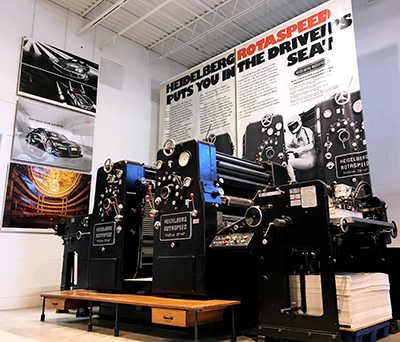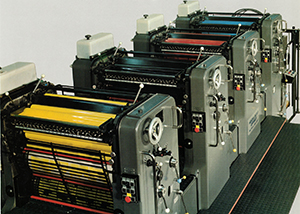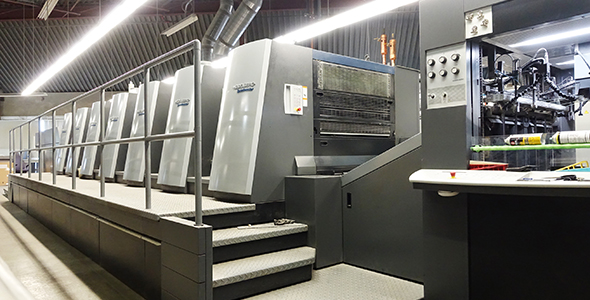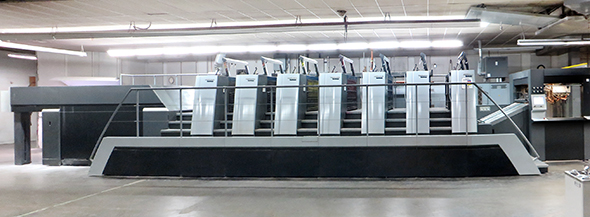
|
|
| Home › Articles › Here |
|

|
||||||||||||||||
| By: Nick Howard | Date: June 2019 | Contact the Author | |||||||||||||||||
|
Inside the offices of Schnellpressenfabrik AG, Heidelberg frustration not seen since the firm’s founding in 1850, filled the hallways of power. A new crop of young executives grew impatient with their boss, Herbert Sternberg. The year was 1961. Heidelberg Druckmaschinen, as the company would soon be renamed, had never entered the offset field. Sternberg was stubborn and believed the future would always be letterpress. After all, Heidelberg was sitting on top in this key sector. At the upper levels of management, Sternberg had a loyal following. Artur Büttner was well ensconced as chief designer, and between the pair, they shared almost 50 years of experience working for Schnellpress. It was Büttner who had led developments of both the T-platen and the OHC cylinder press. Schnellpress had recently added rotary letterpresses to its arsenal – using relief letterpress plates – but this didn’t qualm the younger executives. One who had experience and could see that the future would be in offset was Willi Jeschke. Jeschke had arrived at Heidelberg from MAN in 1956. Soon after, Dr. Wolfgang Zimmermann would be added, and the youth was about to force Herr Sternberg to make a radical decision — build a damn offset press! Taking the existing KRZ rotary model, the engineers made quick work to modify it into Heidelberg’s first offset press. Designated the KOR, or Klein Offset Rotation, the model in the 40 x 57-cm sheet size sold incredibly well when shown at drupa 1962. Heidelberg never looked back, and when the K Offset era ended in 1985, roughly 40,000 machines had left the Wiesloch, Germany, factory. Offset was becoming a major growth industry. Numerous companies were in the business – especially small four-up sizes, but it soon became obvious to Heidelberg that the small KOR had its limits. A larger press, known as the RotaSpeed, would also be redesigned from wrap-around letterpress into an offset. This press, with a sheet size of 71 x 102 cm, was supposed to be Heidelberg’s ticket into the lucrative offset B1 segment. In 1965 this model showcased as a two-colour RZO would make its appearance at TPG in Paris. But the RZO quickly turned out to be a beast. Although it looked great and presented some interesting features, such as five form rollers, the RotaSpeed was awkward to work on. Designed with mirror image print units, the press used a troublesome Spiess BX feeder head and avant-garde grippers instead of belts on the feedboard. This made feeding some papers, such as label stock, challenging.
Only Roland had success using a chain transfer system, and for some unfathomable reason, Heidelberg sought to replicate the concept as it would have been much cheaper than traditional cylinders and gears. With stretched chains causing havoc, even adding “register racks” did not eliminate misregister. By 1967, a new transfer base was designed with cylinders. The writing was on the wall — the RotaSpeed had to go. Thankfully in 1976, Heidelberg put the RotaSpeed out of its misery. Fortuitous for everyone, 1975 was the year Harris-Intertype exited the sheetfed business. Losing such a large competitor was a godsend for Heidelberg, and the company knew it’d have to find a better solution before the likes of Miller and Roland gobbled up market share. Or did they already have something?
In the mid-1960s, the R&D department had been hard at work on a radically new design: The SORD and SOR (or S Offset). At drupa 1967 the model, in a sheet size of 64 x 91.5 cm and 61 x 82 cm, was first shown. SORD was the first Heidelberg offset to be completely engineered from scratch and was it ever a winner! A very easy press to run, the SORD – and its five other variants – kept the RotaSpeed in-feed and transfer gripper system which was first used on the OHC cylinder press of 1935, but that was all. Controls were simple and accessible, and the inker rollers could all be set without tools – and outside of the press. Every roller core was identical, and each roller was fitted with ball bearings. The impression plate and blanket cylinders were easily accessed, as was the in-feed. Little did the Heidelberg engineers realize that the remarkable inking, dampening design, and ease of operating controls would become the basis for the printing industry’s most successful platform: The Speedmaster. The S Offset became an instant bestseller in one- and two-colour models. By 1974, the 102-cm SORS (Z) appeared. Production ended in 1998 and by my count, over 38,000 machines were built.
This new Speedmaster brought many new labour-saving devices to the industry: Speed compensated dampening, motor-driven water pan roller, blanket washers, chromium-plated impression cylinders, and for perfecting machines, replaceable impression jackets. A new suction feeder, which launched in 1971, was a major enhancement and would remain essentially unchanged for the next 20 years. Even those same 1935-designed steel grippers would survive until 1995. All inking rollers had the same core, and with price-pinching printers, this meant they could re-grind rollers, only recovering the smallest ones. That meant a typical inking unit would only need three recovered rollers. This remarkable press grew in popularity because of the operators who loved running it. Anyone with experience running other Heidelbergs soon caught onto offset because the Heidelberg brand maintained the common element throughout all variants. At first, Heidelberg refused to be drawn into a continuous dampener — preferring cloth covering. But in the US, this was a non-starter. Dahlgren and Epic were soon busy slapping its dampeners on so many Speedmasters that Heidelberg had no choice but to come up with its own. In 1979, the first Alcolor-I arrived and to poor reviews. In those days, all manufacturers had to redesign Dahlgrens to circumvent patents. But coming up with a crowned roller obviated the skewing patents, and at drupa 1982, the Speedmaster launched Alcolor-II, and it worked! Soon, five- and six-colours with convertible perfecting washed across the industry. Although Roland had vastly more offset experience, the Speedmaster overnight became the world’s most popular press. By 1986, Heidelberg brought out a new Speedmaster. The CD, or Cardboard Diameter, filled a major weak spot — carton printing. Although the SM 102 could print to 0.8 mm, trying to jam a heavy piece of board around a 10-inch diameter cylinder was near impossible. Many board shops tried anyway, but marking couldn’t be eliminated. The CD had a double-sized impression and triple-sized transfer cylinder, and although initially marketed as a board press, it quickly caught on with commercial printers. Well into the 2000s, the CD enjoyed the crown as Heidelberg’s most prolific sales model after the platen press. In 1988, competition from Japanese and other German manufacturers forced Heidelberg to make changes to the Speedmaster. At the drupa 1990 unveiling, the Speedmaster displayed a new control system (CP-tronic) which did away with electromechanical relays and contactors. The press drive went DC and press speeds increased from 11,000 to 13,000 iph. Still, by 1990, 60 percent of Heidelberg presses left the factory as perfectors; perfecting was so important then. Same slightly narrower grippers and finally the old RotaSpeed Ranger in-feed drum was retired. Drupa 1995 saw another wave of changes. The CD version upped speeds to 15,000 iph by changing the unit side frames. Increased use of pneumatics reduced overall weight and costs. Already in 1993, Heidelberg had offered semi-automatic plate changing (Autoplate) and presetting functions for sheet size and thickness, but this was a period where virtually the rest of the industry caught up to Heidelberg. Although still outselling everyone else, it seemed that small alterations would not protect the Speedmaster’s market share. Heidelberg needed something new again, just like the SORD of 1967. Another brand new platform had to be developed. Grippers and pads, although improved, were a weak spot so was the delivery gripper-bar design. Both were expensive repair areas that had to be upgraded.
The press was under wraps and took a lot of people by surprise. Heidelberg never even mentioned the CD74 in its own commemorative book, 150 Years of Heidelberger Druckmaschinen Aktiengesellschaft, published just prior to drupa 2000. The new model would become a radically new machine that when officially launched in the 105-cm size at drupa 2004, would again eclipse every offset press that had come before. Officially known as the XL 105, the press ignored all previous art of the Speedmaster. Gone were the troublesome gripper systems and now slow semi-Autoplate. In came new inking distribution with faster reaction times, new washing systems, new feeder (Preset-Plus), new delivery, new dampening system, and a double-size impression and transfer arrangement. A brand new perfector with additional (and collapsible) extra cylinder also came a short time later. The XL 105 was a larger version of drupa 2000’s CD74.
Unfortunately, the early 2000s had the print industry in the doldrums as electronic media started to make itself felt. The economy was on shaky ground and adding insult to injury was the new Euro, which had replaced Germany’s Deutsche Mark, and had taken flight against the US dollar and Japanese Yen. It was tough times for Germans making presses, and that included Heidelberg. The offset sales decline had begun, and only a fool expected the good times of pre-2000 to come again. But as the packaging segment continued to grow, Heidelberg found itself riding a wave as it elbowed Koenig & Bauer for a bigger slice of the pie. The new perfector proved to be another winner with the one-pass eight-colour. By 2012, the XL 106 launched and remains today as Heidelberg’s key offset asset. The new simultaneous plate loading feature (Autoplate XL) loads and removes all plates twice as fast and press speeds rose from 16,000 to 18,000 iph. Inpress, colour densitometry closed-loop and built right into the press, first appeared with the XL 105 and has been a major reason why waste has dropped. As part of Heidelberg’s acquisition of Linotype-Hell in 1997, it inherited workflow prepress software. Among them was a patented tool to connect prepress profiles to the press as well as to connect densitometers in a closed-loop fashion. Heidelberg pioneered this CIP4-PPF software, which has been a source of revenue as other press manufacturers were obliged to use it. Since 2004, Speedmaster sought to design an open architecture system to tie in the host of peripherals including dampening, sprayer and dryer. The result was CANopen (Controller Area Network), which does a great job of allowing all devices to communicate with each other. The operator views and interacts with everything from one screen and adjusts settings (such as IR dryer sheet size, dampening, LED/UV and air flow) from one device. Heidelberg has been the leader in tying in ancillary devices. Most competitors leave that task to individual suppliers such as drying, coating, and dampening manufacturers. The “Wallscreen” monitor was also a Heidelberg design and has been widely copied.
Amongst the five big press builders, there are no lemons. Everybody can be proud of what they sell. But Heidelberg has another ingredient that gives it an edge — it excels at product support and superior customer interaction. Whether it be training or spare parts and service, Heidelberg leads by instilling rigour in its quest to connect the German factory with the print shop. Around the world, virtually all sales are carried out by factory-owned units, and it has more technicians in the field with an excellent support network. Service plays a big role in buying decisions, especially in today’s climate. New creative solutions, such as the pay-as-you-go subscription model or groundbreaking system software through Heidelberg’s own Prinect architecture called Push to Stop, have kept the Speedmaster at the top of the offset world for over 40 years. What began as a marvelous S Offset design in 1967 has evolved and is a press with which all others are compared. Like many used machinery dealers, I know this first-hand. We sold every Speedmaster model, including the XL 106, during the past 43 years; Speedmaster was our best seller by far. |
|||||||||||||||||
| Contact the Author | |||||||||||||||||
|
|||||||||||||||









